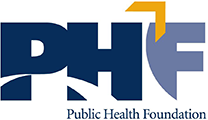Contact tracing is an important tool to help combat the COVID-19 pandemic. It is designed to identify and follow up with people who have been in close contact with infected patients. Building trust with the local community is one important element of contact tracing. People usually trust those that come from the same backgrounds as them because people with similar experiences and from similar contexts “get them.”
To help states, counties, and others develop strategies to better understand their communities’ contact tracing needs, staff at Mathematica and the Public Health Foundation (PHF) partnered to create an interactive dashboard to present key demographic characteristics of trainees who received training through the TRAIN Learning Network as well as the communities they serve. In particular, this effort demonstrates how such a dashboard could help the contact tracing workforce planning team to initiate a discussion about potential strategies to address needs from the community and to develop the most effective contact tracing workforce possible if comprehensive information-including contact tracing workforce data from TRAIN as well as other sources- became available. We should note that this dashboard only presents characteristics of trainees who received training from the TRAIN Learning Network. Other organizations provide contact tracing training as well. We welcome partnership opportunities to update the dashboard with contact tracing workforce data from other sources. Please contact us at CTINFO@mathematica-mpr.com if you would like your information about the contact tracing workforce to be included in the dashboard.
For more background on the dashboard and its potential uses to inform contact tracing efforts, read this blog.
The user selects a specific state or county from the drop-down menu, and details on that county appear in the dashboard.
Dashboard refreshed on December 15, 2021, based on data available as of December 7, 2021. This dashboard is no longer being updated. The Centers for Disease Control and Prevention recommended prioritizing case investigation and contact tracing only in certain settings and for certain high-risk populations.

PHF Contact Tracing Trainees
-
Number of people who received training in contact tracing through the TRAIN Learning Network. This number may not include everyone who has been trained in contact tracing, because people can be trained through other means.
Source:
Public Health Foundation
Alignment chart
The alignment chart shows the demographics of (1) the local community and (2) the people who live in the community and received their training in contact tracing through the TRAIN Learning Network. The alignment score is an indicator of how strongly the demographics of these trainees align with those of the local community. A higher score means stronger alignment.
-
Demographics of the local community and contact tracing trainees.
Sources:
Public Health Foundation
The American Community Survey, U.S. Census Bureau -
When race/ethnicity is not self-reported, it is imputed by using geocoding and surname analysis.
Sources:
https://surgeo.readthedocs.io/en/dev/
https://cran.r-project.org/web/packages/eiCompare/vignettes/bisg.html
COVID-19 indicators
The COVID-19 indicators provide the current status of the pandemic in the community, including:
-
State and county-level cumulative cases and deaths per 100,000 people.
Source:
USAFacts -
Pandemic Vulnerability Index (PVI), an index score that indicates county-level vulnerability to COVID-19. Higher values indicate higher vulnerability.
-
Total number of population and total number of households.
